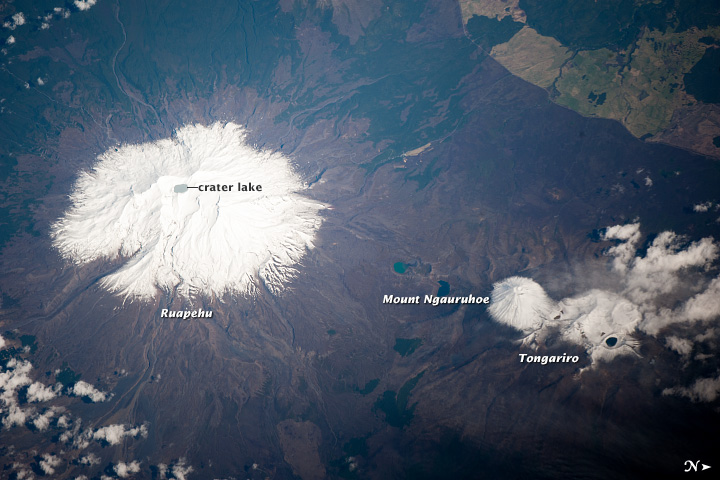NASA: New Zealand - Ruapehu Volcano and Tongariro Volcanic Complex - 11.01.13
Posted by Ricardo Marcenaro | Posted in NASA: New Zealand - Ruapehu Volcano and Tongariro Volcanic Complex - 11.01.13 | Posted on 5:45

acquired September 30, 2013
download large image (332 KB, JPEG, 1440x960)
Mount Ruapehu is the largest and
historically most active of several volcanic centers on the North Island
of New Zealand. At 2,797 meters (9,177 feet), the volcano is the
highest mountain on North Island. In this photograph taken by an
astronaut on the International Space Station, Ruapehu is covered with
snow on its upper slopes.
While there are three summit craters that have been active during the
past 10,000 years, South Crater is the only one that has been active in
modern record-keeping. This vent is currently filled with a lake
(Crater Lake). Eruptions from the vent, mixed with water from the lake,
can lead to the formation of lahars—destructive gravity flows of mixed
fluid and volcanic debris that form a hazard to ski areas on the upper
slopes and lower river valleys. The most recent significant eruption of
Ruapehu took place in 2007 and formed both an eruption plume and lahars.
The volcano is surrounded by a 100-cubic-kilometer ring plain of
volcanic debris that appears dark grey in the image; vegetated areas
appear light to dark green.
Located to the northeast of Ruapehu, the Tongariro volcanic complex
is currently in an active eruptive phase (the previous eruptive phase
ended in 1897). Explosive eruptions occurred
in 2012 and have been followed by steam and gas plumes almost daily.
The volcanic complex contains multiple cones constructed over the past
275,000 years. The most prominent of these, Mount Ngauruhoe, last
erupted in 1975. Like Ruapehu, the upper slopes of both Ngauruhoe and
the upper peaks of Tongariro are snow-covered. Scattered cloud cover is
also visible near Tongariro.
Astronaut photograph ISS037-E-5089
was acquired on September 30, 2013, with a Nikon D3S digital camera
using an effective 650 millimeter lens, and is provided by the ISS Crew
Earth Observations experiment and Image Science & Analysis
Laboratory, Johnson Space Center. The image was taken by the Expedition 37 crew. It has been cropped and enhanced to improve contrast, and lens artifacts have been removed. The International Space Station Program supports the laboratory as part of the ISS National Lab
to help astronauts take pictures of Earth that will be of the greatest
value to scientists and the public, and to make those images freely
available on the Internet. Additional images taken by astronauts and
cosmonauts can be viewed at the NASA/JSC Gateway to Astronaut Photography of Earth. Caption by William L. Stefanov, Jacobs at NASA-JSC.
- Instrument:
- ISS - Digital Camera
NASA: New Zealand - Ruapehu Volcano and Tongariro Volcanic Complex - 11.01.13
Ricardo M Marcenaro - Facebook
Blogs in operation of The Solitary Dog:
Solitary Dog Sculptor:
byricardomarcenaro.blogspot.com
Solitary Dog Sculptor I:
byricardomarcenaroi.blogspot.com/
Para:
comunicarse conmigo
comunicarse conmigo
marcenaroescultor@gmail.com
For:
contact me
For:
contact me
marcenaroescultor@gmail.com
My blogs are an open house to all cultures, religions and countries. Be a follower if you like it, with this action you are building a new culture of tolerance, open mind and heart for peace, love and human respect. Thanks :)
Mis blogs son una casa abierta a todas las culturas, religiones y países. Se un seguidor si quieres, con esta acción usted está construyendo una nueva cultura de la tolerancia, la mente y el corazón abiertos para la paz, el amor y el respeto humano. Gracias:)
(::)


Comments (0)
Publicar un comentario